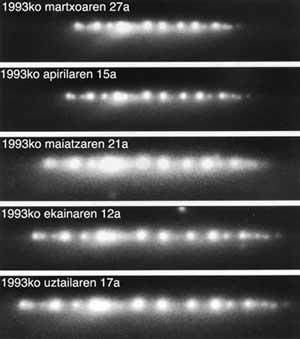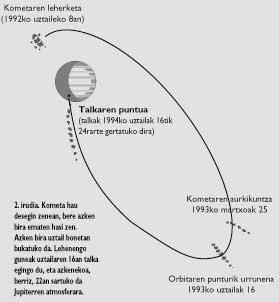Last steps of comet Shoemaker-Levy 9
This July, the planet Jupiter and a comet collide terribly. Never in the history of astronomy has this been seen, a shock against a planet.
In this shock, and according to the latest calculations, 100 million megatons of energy will be released, an incalculable amount of energy. As an example we will say that this energy is 10,000 times greater than all the atomic bombs we had on our planet in the 1980s. All bombs dropped during World War II, including atomic bombs, were only 2 megatons.
The comet, now called Shoemaker-Levy 9, was first seen by astronomers on 25 March 1993. Since then there have been many who have looked at this comet, since its surprising appearance has aroused the curiosity of astronomers. Although very large telescopes have been used, the Hubble Space Telescope has sent the best photos (Figure 1), where 22 points have been found (and not the only one, as is usually normal in comets). It seems that they are part of a comet that has been dissolved by the gravitational forces of Jupiter.

History of the Comet
As it is really surprising to find this type of comet (with so many spaces), the branch of astronomy called celestial mechanics, with incredible computers, began to analyze the history of this comet.
The first calculations revealed a surprising data, confirmed with respect to the data subsequently sent from all observatories. This comet in no case has the orbit of the normal comet, that is, around the Sun. It revolves around Jupiter (Figure 2), which in 1970 was captured after an excessive approach to the planet. Thereafter the comet became the anonymous satellite of Jupiter, although it is still known as comet.
But it seems that this comet or satellite contained some small unforeseen. In July 1992 it passed so close to the surface of Jupiter, where mareal forces exploded (these mareal forces are gravitational forces). All this data is provided by the computer and, although they have no direct proof of it, they are quite reliable.
When this comet was undone, he began his last tour, with his heart dissolved trying to kill himself. The last tour ends this July. The first zone collides on 16 July and the last one enters the atmosphere of Jupiter on 22 in this agony that will last six days.
The data are not yet fully detailed, but in view of the data sent from the Jet Propulsion Laboratory of California to the IAU, the first focus collides on July 16 at 19 h 45 min (UT).

Shock Energy
According to the data obtained through the aforementioned computers, the relative speed between the comet and Jupiter at the time of the impact will be 60 km/s. Knowing this data is easy to measure the energy that will be released. (Based on the principle of conservation of mechanical energy without knowing this data, it would be possible to calculate it, but we will not begin to do so.)
Knowing this speed, we know what will be the kinetic energy of the comet at the time of the shock, which will be the released energy. The formula we will use to calculate kinetic energy is as follows: No = (m . v2) / 2, being m the mass of the comet and v the speed. As we know speed, we lack mass to know all the data.
For calculation of mass it is necessary to know density of a kite which we will call ñ, and volume. Therefore, m = ñ · V, and if we consider that a comet point has the shape of a sphere, m =\ · 4 / 3 ·<r3. <r3.
We have trouble calculating density. What density can we take? Any comet or asteroid, for example? Or should we take another density? Scientists do not agree, but as it has a kite shape we will take the kite density. This can certainly be the first fault in calculations. Note that ñ = 1 g/cm3, may be smaller (or larger). Thus No = 1 / 2 · ñ · 4/3 · r3 · v2 = 7.54 · 1021 · r3. This formula will give us energy in joules if we put radius in kilometers.
The most difficult thing is to appreciate these radios, since in the photos the areas appear inside a cloud of dust and gas. Also, seeing such small things at these distances is not easy. It would be like seeing a coin of twenty hard to 4,000 kilometers in proportion. In other words, it would be like seeing on the Moon the Apollo probe from Earth.
The latest calculations indicate that we will not realize how they have done it, the maximum diameter of the largest area is 4.3 km. Being the radius half the diameter, we can calculate the kinetic energy of this core: 7.5 · 1022 joules. Considering all nuclei or nuclei, its kinetic energy is 4,31· 1023 joules. It must be said that many researchers believe they are smaller.
To understand this energy we will give some examples.
The kinetic energy of a car a hundred kilometers per hour, with a mass of 1.5 tons, will be 5.78 · 105 joules. The well-known Boeing 747, with a mass of 300 tons and a speed of 1,000 km/h, has a kinetic energy of 1· 1010 joules.

The energy that burns worldwide for a year is 1019 joules. The reader will realize that the energy of jokes is not at all. And if we compare it with the earthquake that on Earth are “catastrophic,” we will see it more clearly. Gutenberg and Ritcher noted that the energy of the magnitude 8 earthquake is 1017 joules. We all know their incredible influences. Being the energy of the greatest almost a million times greater... Well. Less bad than the goal of the comet is Jupiter and not the Earth.
However, comparing the masses, the comet is much smaller than that of Jupiter. This collision would be as if an ant hit the transatlantic Queen Elizabeth (taking into account the masses). Therefore, the shock will be grotesque, but considering the mass of the planet, it will not affect the orbit of Jupiter.
Influence of collision in Jupiter's atmosphere
It is not yet clear what the impact of this shock will be, especially since entering the atmosphere does not know the behavior of the comet.
As the bodies enter the atmosphere of Jupiter they lose their speed and become a fireball next to the surrounding atmosphere (Figure 3).
Friction with bodies and surrounding atmosphere allows atmospheric gases to be heated to 10,000 degrees. This will cause a large atmospheric mass to advance to cooler regions. As the mass rises, atmospheric gases expand and cool. The different compounds present in this mass condense into a large cloud.
In addition, scientists do not agree to decide how far the bodies will enter. Some believe that they will disintegrate into the upper part of the atmosphere and others believe that they will melt hundreds of kilometers deep.
On the other hand, since the atmosphere is an elastic medium, the collision is expected to produce an elastic wave, as seen in figure 4 in computer simulations.
It will not be possible to directly see shocks from the ground, as shocks with our point of view occur at the back of Jupiter. However, in the 4 big moons of Jupiter you can see the reflection of the explosion. The impact of the collision will be seen even in a few hours after the crash, as Jupiter rotates very quickly on its axis (in ten hours).
Therefore, during these days, in addition to the ground-based telescopes, will be the newly repaired Hubble Space Telescope and the Voyager and Galileo probes looking at Jupiter. Voyager is far away, but he will see the shock directly, taking measurements of the shock brightness. Galileo, for his part, will not see him live, but for his position, he will see the areas of the shock a few minutes later. However, you will not be able to send more than 100 photos, as it has the main antenna broken. All these tools will allow to analyze all the effects mentioned. In this way the atmosphere of Jupiter and the structures of the comet will be better known.
Can it happen on earth?

Saying would not be a lie. If the orbit of any comet or asteroid crosses that of the Earth, it can collide with the Earth. And these kinds of shocks do happen.
The shocks that occur in most cases are very small, although sometimes they are noticeable. Tunguska (see Elhuyar. Science and Technology, numbers 66 and 67), near the river (in Siberia), for example, in 1908 the part of a comet containing 20,000 kilotons (0.02 megatons, 5,000 million times less than the Shoemaker-Levy) exploded the territory of 2,000 square kilometers. Such shocks, such as that of Siberia, occur once a century according to some scientists. Others, however, say they are not so abundant. Larger shocks are even rarer, especially because small comets or asteroids are much more numerous than large ones.
Rarely can we see such a strange shock in our Solar System. Therefore, let us carefully see the impact of this shock and enjoy the images emitted by the telescopes, since we cannot see it again.





